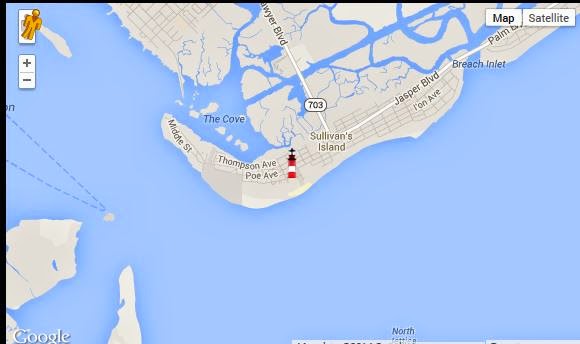Been here many times before, but not to get the stamp- which I got today.
The modern monolithic Sullivan’s Island Lighthouse, the last major lighthouse built by the federal government, resembles an air traffic control tower more than a traditional lighthouse. The tower's unique triangular shape, with one point directed towards the ocean, allows it to withstand winds of up to 125 miles per hour.
When erosion threatened Morris Island Lighthouse, located south of Charleston Harbor, the decision was made to construct a replacement beacon on Sullivan’s Island, north of the harbor’s entrance. Although the triangular tower, built of concrete and steel and clad in a skin of aluminum, doesn't have much Southern charm, it does have some redeeming qualities. Inside the tower, the keepers of the light are treated to air conditioning and an elevator that offers a leisurely, seventy-four-second trip skyward. After the elevator ride, it is still necessary to scale a twenty-five-foot vertical ladder to reach the lantern room, where a powerful light source is housed.
|
Charleston Lighthouse was originally painted white and red-orange, but the coloring proved so unpopular that the tower's daymark was soon changed to the current black-top, white-bottom paint scheme.
The high-tech Charleston Lighthouse overlooks one of the South’s oldest and most historic cities. Just down the street from the lighthouse is Fort Moultrie, named after William Moultrie a Revolutionary hero responsible for building an earlier fort on the same site. Moultrie and his men repelled a British armada on June 28, 1776, supplying momentum to the quest for independence that would be officially declared just six days later. Fort Sumter is located just offshore from Fort Moultrie. In April of 1860, Confederate forces in Fort Moultrie fired on the Federal soldiers in Fort Sumter, marking the beginning of the Civil War.
The 163-foot-tall triangular lighthouse is not the first to be built on Sullivan’s Island. Records indicate that two "pole-beacon lights" were placed near the southern end of the island near Fort Moultrie in 1848 to guide mariners over Charleston Bar. The range lights were destroyed during the Civil War, but after the surrender of Charleston in the spring of 1865, a temporary, open-framework tower was placed atop a private residence. Formal range lights were established in 1872 with the front beacon being displayed from a wooden tower on the fort's parapet and the rear beacon from a square, open-framework tower. The front range light was moved from the parapet to a point east of the fort in 1878, and the following year, the wooden tower was placed atop a brick basement that functioned as an oil room. The front tower was painted red in 1883.
In 1898, a lifesaving station was built on Sullivan’s Island. The station’s dwelling and boathouse still survive next to Sullivan’s Island Lighthouse, and were used by the coastguardsmen manning the light.
Mike Sejman served at the lighthouse in the 1970s, when the station was staffed by a 1st class petty officer serving as the Commanding Officer, a 2nd class petty officer, and two non-rated crew members. Speaking to a reporter from the The Charleston Observer in 1976, Sejman mused, "It's a little sad sometimes to think that pretty soon they are going to automate the light here and they won't need us any more. I guess all the romance is about gone out of lighthouse keeping. I'm sorry too. I like it."
|
In 1986, the National Park Service took over the lifesaving station property, excluding the lighthouse, and started to use the historic buildings as offices, maintenance shops, and housing for seasonal rangers.
On May 29, 2008, Charleston Lighthouse was also transferred from the Coast Guard to the National Park Service, which is committed to protecting the historic nature of the property and to prevent commercial development on the site. The Coast Guard will continue to maintain the light, but the Park Service will be responsible for the upkeep of the tower.
On the official transfer day for the lighthouse, Bob Dodson, superintendent of Fort Sumter National Monument, met with Chief Boatswain's Mate Andrew White, the Coast Guard's local officer in charge of aids to navigation, to obtain the keys and security code for the tower and to discuss maintenance and access issues. "You are relieving me of a big burden by taking over the lighthouse," White said, noting that his crew of ten were responsible for monitoring and maintaining about 600 navigational aids along the South Carolina coast. Due to the difficulty of accessing its lantern room and viewing platform, Charleston Lighthouse will not be open to the public on a regular basis, but the Park Service has not ruled out an annual or semi-annual open house.
A celebration for the earlier transfer was held at the lighthouse on November 9, 2008. At that time, the grounds, lifesaving quarters, boathouse, and the base of the tower were open to the public. A symbolic key transfer was held, with local officials participating.
On January 7, 2009, Jack Graham, accompanied by his wife Martha, stopped by Sullivan's Island Lighthouse. Making it to the top of the tower that her husband designed was on Martha's "bucket list." Jack Graham completed his architectural training at the University of Pennsylvania in 1957 under the tutelage of Louis Kahn, who was obsessed with triangles. A year after graduating, Graham learned he would be drafted, so he signed up with the Coast Guard and was stationed at Coast Guard Headquarters in Washington, D.C. In 1959, he was asked to come up with a design for a lighthouse, and given his background, he based it on a triangle, the strongest structural shape. Graham also persuaded the Coast Guard to install the elevator in the lighthouse because of the numerous reported accidents that occurred on lighthouse steps.





No comments:
Post a Comment